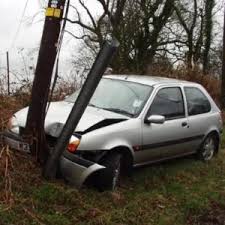Defensive Driving Tip #33: Avoid the Single-Vehicle Collision
When thinking about defensive driving many people think about what the most “dangerous” collision is, they don’t always come up with the correct answer on first guess. Many think it is the “T-Bone” (a 90 degree impact at an intersection), or a head-on. These are serious collisions, and along with rear-end collisions, account for many traffic deaths each year. But time and again, the statistics show that the collision that kills more of us than any other is the single vehicle, off the road collision.
If you think about their causes, then the ways to prevent them become obvious — they happen when we lose control for one reason or another. The driver might be distracted for a moment, or fatigued and drift off to sleep. A one-car crash can occur with a loss of traction (and an uncontrolled skid, or even with a tire failure. Driving under the influence contributes to a great number of these crashes each year; in my state, recent numbers show that about 35% of crashes are a result of impairment.
The “classic” one-car crash results when a vehicle does a slow drift to the right, and hits the dirt, or perhaps the rumble strips on the right shoulder of the road. Typically, the driver gets alert at this point, and overreacts, jerking the wheel left to bring the vehicle back onto the road. That “jerk” to the left causes the front left tire to strike the raised edge of the pavement at a fairly sharp angle — often causing a rollover or a swerve into the oncoming lanes to the left. Why “classic?” Because investigating officers will tell you they see this type of mishap so often, it is now a cliché.
In defensive driving an ounce of prevention… The most important defense you have against death or injury in this type of collision is your seat belt. In a crash, cause of death is often ejection from the vehicle (the single greatest cause of death in motor vehicle collisions). You can die from the simple impact injuries you suffer, or be run over or crushed by your own vehicle as it rolls, or be run over by others (such as emergency vehicles) as they arrive. This is not a rare occurrence.
The preventive cures are simple. Avoid distractions, use your defensive driving skills, avoid highway hypnosis (that groggy, hum-drum feeling you get on long, straight, flat roads), be careful about maintaining control and traction, keep your speed prudent for the conditions, and make sure your tires (and other equipment, like your brakes) are in good condition and properly maintained. Make sure you are up to the task of driving — well-rested, especially after successive days of long-driving-hours. Stay focused on the responsibility of driving, consume NO alcohol before or during driving, and be careful about over-the-counter or even prescription drugs — they are just as dangerous as alcohol if they impair your driving abilities and just as illegal (read the label, if it says don’t drive, then DON’T).
If you find yourself drifting off the right edge of the pavement, release the accelerator and let the vehicle slow as you continue straight ahead along the shoulder, then use the steering wheel to bring the vehicle smoothly back onto the pavement. You can use the brakes while slowing, but be careful not to apply them too heavily, and make sure you are not trying to turn while braking. If you get a ticket take our defensive driving course www.2passdd.com

